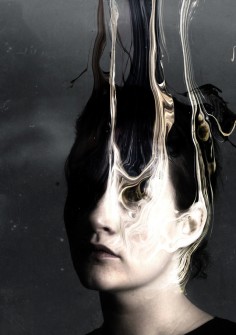Sóley
ask the deep
Ævintýr

source: soleysoley
A beat is laid out, hesitantly moving along at first, then careering, taking off; soon sepia-toned clouds of piano gather overhead, shimmering, turning darker and richer, and then Sóley raises her voice – a voice that, until five years ago, she didn’t even consider a proper “singing voice”. It’s true: the bespectacled multi-instrumentalist from Iceland, now in her mid-twenties, had been around the world and back with her band, Seabear, when she finally discovered her own vocal skills. Even though Sóley Stefánsdóttir sings non-stop in private, creating a musical backdrop to pretty much everything she does, it just took her a while to get used to the sound of her own voice. We all know this, don’t we?
.
.
.
.
.
.
.
source: morrmusic
Born in Hafnarfjörður, Iceland, Sóley has been wowing audiences around the globe with her dark, fairytale song craft since 2010. After the “Theater Island” EP (2010) announced her as a solo musician, the fantastical, sepia-toned alt-pop tunes of debut full-length “We Sink” (2011) won her a massive, devoted fanbase: Often praised for her delicate take on composition, her songs’ “dream-like” qualities and “dark surrealism”, a track like “Pretty Face” has gained over 17 million YouTube views since its release. Having studied piano and later composition at the Icelandic Art Academy, Sóley Stefánsdóttir, who was formerly a member of the band Seabear, released a short EP entitled “Krómantík” in 2014, comprised of piano works originally composed for various theater/film productions, and is now about to return with her sophomore album „Ask The Deep“ in early 2015. Still drawn to dark, nocturnal themes,„Ask The Deep“ sees the bespectacled multi-instrumentalist branch out musically, both charting new sonic territory – and fighting the devil inside. Often inspired by poetry, Sóley’s tunes are the musical equivalent to dark fairytales, lucid dreams and childhood nightmares.
.
.
.
.
.
.
.
source: psimusic
Über die Stille, die zurückkehrt, sobald ihre letztes Jahr veröffentlichte „Krómantík“-EP ausklingt, hat Sóley seinerzeit gesagt: „… langsam erkennen die geschlossenen Augen etwas sehr viel Abgründigeres und Dunkleres“. Jetzt ist er da, dieser Abgrund, er liegt direkt vor uns: „Ask The Deep“, das zweite Soloalbum der Isländerin, ist in der Tat sehr viel abgründiger, sehr viel persönlicher noch als die minimalistisch-düsteren Klavierkompositionen jener EP. Begleitet von Geisterschiffen und einer klanglichen Landkarte, die ohne die einstigen Klavierkoordinaten auskommt, bahnt ihre weiche, warme Stimme den Weg, während wir immer tiefer in die geheimnisvollen Märchenwelten eintauchen, die sie mit ihren bisherigen Releases, der „Theater Island“-EP und dem „We Sink“-Debüt (2011), nur angedeutet hat.
.
.
.
.
.
.
.
source: monkeybuzz
“À noite, ou quando estiver frio e chovendo lá fora, sente em uma cadeira na sala e escute. Se você quiser, dance um pouquinho. Imagine um piano um pouco desafinado no canto, daí imagine mãos velhas. Essas mãos velhas tem uma história pra contar. Essas mãos quase não sao de verdade, mas fica difícil saber só de escutar. Essas mãos vão tocar até Kromántik se dissipar no silêncio e seus olhos fechados começarem aos poucos a ver algo mais profundo e escuro”.
É assim que a islandesa Sóley explica este EP de músicas feitas no piano, um intervalo produtivo entre seu primeiro álbum, We Sink (2011), e um futuro lançamento. Diferente das músicas que a tornaram conhecidas entre o público que curte nomes como Lykke Li, o trabalho aqui é quase totalmente instrumental, com as vozes participando uma vez aqui e outra ali também como timbres na música, sem nenhuma letra.
Mas isso não significa que as músicas não trazem uma mensagem. Como ela disse, as mãos “tem uma história pra contar”, talvez duas ou três. O som tem aquele apelo que chamamos de vintage, algo que facilmente nos remete à infância – na verdade, ao passado como um todo, mas os tempos como criança é a história mais distante que um jovem pode ter, então é aí que as imagens ficam.
Pode ser um carrossel ou algum outro brinquedo de parque de diversão em uma representação da memória com a cores douradas e avermelhadas já enferrujadas, ou uma caixinha de música na casa da vó, com suas estampas e bordados decorando os móveis de madeira. Minha leitura da obra é mais doce e menos obscura do que a proposta pela cantora, mas não dá pra negar uma aura um tanto quanto dark no EP.
Como Sóley avisou, “this is not Pop music”. Porém, essa possibilidade de conexões emocionais com lembranças pessoais faz desta obra, de composições muito bonitas, uma dica certeira para quem tem ouvido discos como Romantic Works, de Keaton Henson.

